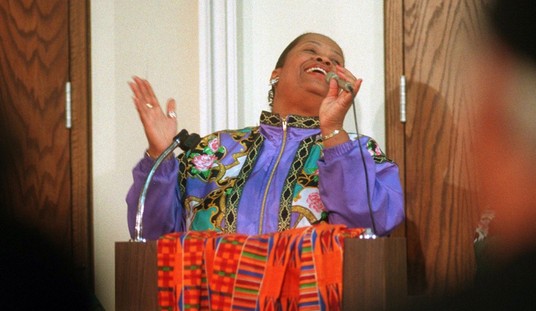It’s the end of the world as we know it (it’s time I had some time alone)
It’s the end of the world as we know it (it’s time I had some time alone)
It’s the end of the world as we know it and I feel fine (it’s time I had some time alone)
– R.E.M “It’s The End of The World As We Know It (And I Feel Fine) Lyrics. (HT: Lyrics007)
Perhaps we are all fortunate that Walter M. Miller, Jr. wrote A Canticle For Leibowitz before the era of Global Warming Chic. He, Neville Shute, and all the fine Rock Singers who jammed at the No Nukes Concert, seemed to believe there wasn’t a silver lining around the mushroom shaped cloud of a nuclear holocaust that didn’t consist of Strontium-90.
Now, our scientific overlords inform us that if you just pop a few nukes, somewhere far away from where Dr. Genius parks her SUV, it may not be a total suckage field. Nothing quite reverses the Demon Global Warming like a nice, billowing cloud of carbonaceous aerosols. These particles, known in Atmospheric Science literature as Black Carbon, could potentially exert a downward forcing effect on global temperature by blocking incoming insolation.
In small quantities, these aerosols are seen as having a positive forcing effect. They heat the air by storing and reemitting heat from the sun and by coating reflective surfaces on the ground. But what happens if you produce a quantity described by Carl Sagan as “Billions and Billions and Billions?”
In 1983, Sagan, Richard Turco and a large number of other researchers examined what would happen if the USSR and the United States detonated a combined explosive capacity ranging from 5,000 to 10,000 megatons. This resulted in a paper entitled “Global Atmospheric Consequences of Nuclear War.” This research paper introduced a new term to the scientific discussion of catastrophe – Nuclear Winter.
One synopsis of the Nuclear Winter hypothesis holds that a 10,000 megaton discharge of atomic weaponry would “accomplish” the following:
The conditions of semidarkness, killing frosts, and subfreezing temperatures, combined with high doses of radiation from nuclear fallout, would interrupt plant photosynthesis and could thus destroy much of the Earth’s vegetation and animal life. The extreme cold, high radiation levels, and the widespread destruction of industrial, medical, and transportation infrastructures along with food supplies and crops would trigger a massive death toll from starvation, exposure, and disease.
Nuclear Winter consisted of a hypothesis tested with a model. Thus, rigorous-minded people will dispute the validity of the conclusions in the aforementioned paper. In fairness to the authors, nobody still in their tree would actually call up the Pentagon and ask them to test this puppy out in the name of good, accurate science. However, real-world events have partially mimicked Nuclear Winter on a much smaller scale.
From 12 to 15 June 1990, Mt. Pinatubo erupted in the Philippines. The United States Geological Survey writes the following regarding this catastrophic natural disaster.
…the volcano exploded in a cataclysmic eruption that ejected more than 1 cubic mile (5 cubic kilometers) of material. The ash cloud from this climactic eruption rose 22 miles (35 kilometers) into the air. At lower altitudes, the ash was blown in all directions by the intense cyclonic winds of a coincidentally occurring typhoon, and winds at higher altitudes blew the ash southwestward. A blanket of volcanic ash (sand- and silt-size grains of volcanic minerals and glass) and larger pumice lapilli (frothy pebbles) blanketed the countryside. Fine ash fell as far away as the Indian Ocean, and satellites tracked the ash cloud several times around the globe….Nearly 20 million tons of sulfur dioxide were injected into the stratosphere in Pinatubo’s 1991 eruptions, and dispersal of this gas cloud around the world caused global temperatures to drop temporarily (1991 through 1993) by about 1°F (0.5°C)
So guess what some sick and benighted members scientific establishment have obliquely proposed to solve our Global Warming Crisis? I like to describe it as Nuclear War’s NFL Pre-season. We’ll keep Peyton Manning on the bench and proceed as follows.
To see what climate effects such a regional nuclear conflict might have, scientists from NASA and other institutions modeled a war involving a hundred Hiroshima-level bombs, each packing the equivalent of 15,000 tons of TNT—just 0.03 percent of the world’s current nuclear arsenal.
In return for this small, short-term investment in thermonuclear HVAC, we get the following “pay-off:”
After a regional nuclear war, though, average global temperatures would drop by 2.25 degrees F (1.25 degrees C) for two to three years afterward, the models suggest. At the extreme, the tropics, Europe, Asia, and Alaska would cool by 5.4 to 7.2 degrees F (3 to 4 degrees C), according to the models. Parts of the Arctic and Antarctic would actually warm a bit, due to shifted wind and ocean-circulation patterns, the researchers said. After ten years, average global temperatures would still be 0.9 degree F (0.5 degree C) lower than before the nuclear war, the models predict.
(National Geographic)
As long as were just proposing an undercard bout rather than the next installment of Ward Vs. Gatti, National Geographic doesn’t seem to sweat the whole unintended consequences category. Being the Ops. Research type that I am; I decided to nerd around a bit in the negative externalities. They seemed to suggest India versus Pakistan as a possible conflict that generates the right volume of smoke and ash. So I decided to look up what sort of targets the two opponents would seek to flash-fry.
Mombai has 13.8 Million People, Delhi has 12.6 Million and Bangalore and Kolkata top out a shade over 5 million each. Assuming the Pakistani attack generates 50% KIAs in each of these for cities, we get around 18M worth of instantaneous carbon sequestrations.
If India inflicts similar damage on the top four Pakistani cities, we would experience about 12M units of human CO2 emitter reductions. And not to bug these scientific wonder-kids in the middle of dinner, but what I’ve just described involves an hypothesized 30 million deaths. It required the Good ‘Ol US of A about 25 years of Roe V. Wade abortions to generate the same despicable level of casually sadistic genocide. So much for American Exceptionalism.
People have a lingering, false impression that environmental activists actually like the continued existence of human beings. To suggest that India and Pakistan could do us all a favor and cool the planet for a few years if they unleashed hell across their contentious mutual border lays this assertion utterly to nines. Not all environmentalists are genuinely evil, but like the population activists that encourage you not to breed, they are certainly not interested in mankind’s commonweal.














Join the conversation as a VIP Member